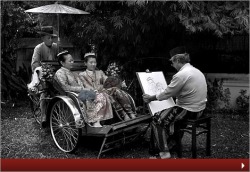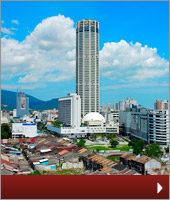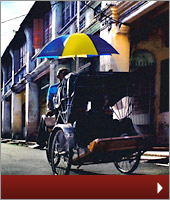PENANG BACK IN THE DAY...

- The Betul Nut Tale
Before Penang, the Pearl of the Orient, was known to the world as a beautiful, exotic holiday destination, she was Pulau Pinang – a virgin paradise that got her name from the abundance of betel nut palms scattered across her soft, sandy beaches.
Literally translated, Pulau Pinang means the “Isle of the Betel Nut” in Malay – Malaysia's national language. Steeped in history, “Penang” was born when charismatic English captain Francis Light persuaded the Sultan of Kedah to cede Pulau Pinang to the British East India Company.
In 1786, Light landed on what is known as the scenic Esplanade today. Local folklore tells of how he fired gold coins into the surrounding jungle to induce his men to clear the area. Fourteen years later, the Sultan of Kedah further ceded a strip of land on the mainland across the channel to a very persuasive Light.
The state of Penang then comprised of an island originally named Prince of Wales Island, after George V, and the strip on the mainland which was christened Province Wellesley, after the Governor of India. The former was later named George Town, after King George III.
In 1832, Penang formed part of the Straits Settlement with Malacca and Singapore. The Penang maritime port was among the busiest in the region, attracting rich merchants involved in the lucrative trade of tea, spices, porcelain and cloth.
Settlers and fortune-seekers from the all over called Penang home and it was from this interesting mix of Chinese, Malay, Indian and Siamese (to name a few) cultures that Penang became a melting pot for hybrid communities – the most famous being the Baba Nyonya, Jawi Peranakan and Eurasians.
For more than a century, the major trading post remained under British colonial rule until 1957, when Malaysia gained independence. George Town was accorded city status by Queen Elizabeth II on January 1, 1957, thereby becoming the first town in the Federation of Malay – after Singapore – to become a city.
Although she is Malaysia's electric and electronic manufacturing hub, Penang has successfully retained her old world charm. As recognition of her rich heritage, George Town, together with Malacca, was listed as the United Nations Educational, Scientific and Cultural Organization (UNESCO) World Heritage Site on July 7, 2008.
What Every Traveller Should Know...

Geography
Situated along the north-western coast of the peninsula, Penang is Malaysia’s only “island state”. Locals are fondly known as Penangites, many of whom will proudly tell you that the state comprising a population of approximately 1.5 million, is a close-knit community of diverse ethnicities, cultures and dialects.
One of Malaysia’s premier holiday destinations, the 285km2 island is separated from Seberang Prai (formerly Province Wellesley) – a hinterland of 737km2 on the mainland, by a narrow 3km channel.
You can either cross the channel via the iconic Penang Bridge or by the ferry – the latter being a “must experience” simply because it is synonymous with holidaying here. Soon, visitors will have the option of using the new Second Penang Bridge which is expected to be completed in 2011.
Situated along the north-western coast of the peninsula, Penang is Malaysia’s only “island state”. Locals are fondly known as Penangites, many of whom will proudly tell you that the state comprising a population of approximately 1.5 million, is a close-knit community of diverse ethnicities, cultures and dialects.
One of Malaysia’s premier holiday destinations, the 285km2 island is separated from Seberang Prai (formerly Province Wellesley) – a hinterland of 737km2 on the mainland, by a narrow 3km channel.
You can either cross the channel via the iconic Penang Bridge or by the ferry – the latter being a “must experience” simply because it is synonymous with holidaying here. Soon, visitors will have the option of using the new Second Penang Bridge which is expected to be completed in 2011.

The Economy
From the 1970s to the late 1990s, the state’s Free Trade Zone in the Bayan Lepas area was one of Asia’s largest electrical and electronics manufacturing bases. The area south of the island is now the Bayan Lepas Free Industrial Zone. Key exports include electrical and electronic products, semi-conductors, computer products, medical devices, textiles, gold and jewellery.
Penang’s medical tourism and education sectors continue to grow steadily as the state’s industrial sector moves towards high-end manufacturing activities and up the value-chain. The service sector driven by knowledge-based workers is the next frontier as the state focuses on research and development and innovation.
From the 1970s to the late 1990s, the state’s Free Trade Zone in the Bayan Lepas area was one of Asia’s largest electrical and electronics manufacturing bases. The area south of the island is now the Bayan Lepas Free Industrial Zone. Key exports include electrical and electronic products, semi-conductors, computer products, medical devices, textiles, gold and jewellery.
Penang’s medical tourism and education sectors continue to grow steadily as the state’s industrial sector moves towards high-end manufacturing activities and up the value-chain. The service sector driven by knowledge-based workers is the next frontier as the state focuses on research and development and innovation.

The People and the Language
Penangites comprise mainly of three main ethnicities – the Chinese, Malays and Indians. Penang is the only state in Malaysia with an ethnic Chinese majority which explains why many Chinese cultural and religious festivals are celebrated here on a large scale.
Nonetheless, the Malay and Indian communities' influence form the very essence of the state and this is evident in many of the buildings, food and local dialects.
Although Bahasa Malaysia or Malay is the national language, English is widely spoken here. Many tourists are surprised and impressed by the level of proficiency.
What makes Penang unique however, is the Hokkien dialect spoken by the Chinese community. Unlike in other states, the more popular Cantonese and Mandarin take a backseat to the unique Hokkien dialect brought here by the early Chinese settlers from the Fujian Province in China.
Penangites are a friendly lot and are more than happy to share their knowledge on local customs and must see places – indeed, nothing beats a local's perspective!
Penangites comprise mainly of three main ethnicities – the Chinese, Malays and Indians. Penang is the only state in Malaysia with an ethnic Chinese majority which explains why many Chinese cultural and religious festivals are celebrated here on a large scale.
Nonetheless, the Malay and Indian communities' influence form the very essence of the state and this is evident in many of the buildings, food and local dialects.
Although Bahasa Malaysia or Malay is the national language, English is widely spoken here. Many tourists are surprised and impressed by the level of proficiency.
What makes Penang unique however, is the Hokkien dialect spoken by the Chinese community. Unlike in other states, the more popular Cantonese and Mandarin take a backseat to the unique Hokkien dialect brought here by the early Chinese settlers from the Fujian Province in China.
Penangites are a friendly lot and are more than happy to share their knowledge on local customs and must see places – indeed, nothing beats a local's perspective!

Getting Around
Trishaw, taxi, rented car, motorcycle and bicycle or public bus – you choose. Of course there various modes of transportation in the state but it really depends on where you are planning to visit.
If it is within the George Town UNESCO Heritage Site you want to explore, the trishaw is a good bet because all the famous landmarks are just a stone’s throw away from each other. Besides its quaint charm, the trishaw ride is relaxing and a great way to take in the sights. If you would rather walk or cycle, the Penang Heritage Trust (PHT) has a great heritage trail you can embark on.
To travel around the island, the air conditioned Rapid Penang public bus service is quite reliable and their drivers are a helpful lot. Just make sure you have a comprehensive map in hand!
You can also opt to rent a motorcycle or car or hire a taxi for the day if you want to see other landmark attractions outside the George Town inner city enclave.
Trishaw, taxi, rented car, motorcycle and bicycle or public bus – you choose. Of course there various modes of transportation in the state but it really depends on where you are planning to visit.
If it is within the George Town UNESCO Heritage Site you want to explore, the trishaw is a good bet because all the famous landmarks are just a stone’s throw away from each other. Besides its quaint charm, the trishaw ride is relaxing and a great way to take in the sights. If you would rather walk or cycle, the Penang Heritage Trust (PHT) has a great heritage trail you can embark on.
To travel around the island, the air conditioned Rapid Penang public bus service is quite reliable and their drivers are a helpful lot. Just make sure you have a comprehensive map in hand!
You can also opt to rent a motorcycle or car or hire a taxi for the day if you want to see other landmark attractions outside the George Town inner city enclave.
